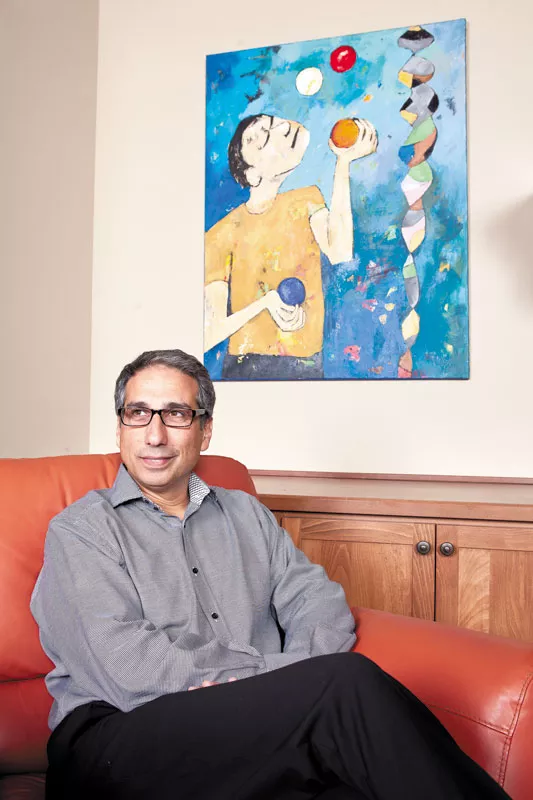Bassem Bejjani was always good in school. And when you’re raised in Lebanon and good in school, the paths forward are pretty clear. “You either become an engineer or a doctor or a lawyer,” Bejjani says.
Bejjani was interested in science as a kid, but better at biology than “the hardcore sciences,” so he became a physician and geneticist, founding a groundbreaking genomics company in Spokane in 2003.
Bejjani has never played an instrument, though his brother did. He doesn’t really paint or draw. But in mid-September, after spending a year on the board of the Spokane Symphony, Bejjani was appointed a Washington State Arts Commissioner.
He says his commitment to the arts is a duty he feels to a community that has supported him, but it also goes deeper than that. Bejjani believes science and art are fundamentally linked, that creativity fuels innovation and that when we cut arts budgets in schools, we do so at our own economic and cultural peril.
When he came to America in 1987 — leaving Beirut to flee Lebanon’s civil war — the first job Bassem Bejjani could get in the medical field was at a Boston-area genetics lab. He worked to get his medical license in America and went into pediatrics, moving from the University of North Carolina to the Baylor College of Medicine, where he taught, oversaw a research program and had a clinical practice treating genetic conditions in children.
In 2003, Sacred Heart recruited Bejjani and a colleague, Lisa Shaffer, to come to Spokane, where they founded Signature Genomics. The company did pioneering work to use microarrays, a research technology that allows many different genetic tests to be completed simultaneously, in a clinical setting.
The industry at the time didn’t think this was possible. Colleagues gave Bejjani and Shaffer a raft of reasons it wouldn’t work, he says, ticking them off: “It’s clunky. It’s expensive. It’s slow. It works only 20 percent of the time. It needs a lot of specialization and people to do it and to interpret it.”
But the company worked through all these issues, getting costs down, making the tech more reliable and easier to use. They were the first company to bring the devices to the clinical market. “We proved that it can work clinically and that it is, in fact, very helpful,” Bejjani says.
Nine years later, he says, microarrays “are the standard of care.”
Science operates under certain rules and presuppositions. “Richard Feynman said, ‘Science is imagination in a straitjacket,’” Bejjani says. “In science, you are letting your imagination loose, but you are bound by the laws of physics and chemistry and math.”
But sometimes, Bejjani says, the rules we abide by aren’t given to us by the universe; they’re created by our own sense of the status quo. “Whenever you are in the straitjacket of science, sometimes you impose on yourself rules that don’t exist,” Bejjani says. This is what had happened with microarrays. Conventional wisdom that they were too expensive and cumbersome had become a rule of the marketplace.
“It’s when you see that these rules are self-imposed — and you then break them,” Bejjani says, “that innovation happens.”
Signature Genomics was the first company to break the microarray rules, and they were rewarded with a brand new market and a slew of competitors scrambling to keep up. That’s where a grounding in the arts comes in, Bejjani says.
Rule-breaking in the arts, especially in the last 100 years, has become a broad, disruptive creative impulse. “Think about painting — think about Picasso and the surrealists,” Bejjani says. “Since the Renaissance, people had two eyes, one nose, one mouth and they were drawn to all the right proportions. And the masters did beautiful paintings. But then, in the early 20th century, somebody said, ‘To heck with it, I’m changing it.’”
Bejjani believes progress is built around this sort of disruption. “This is how humanity progresses, too, right? Think of where humanity was before Gutenberg — before the printing press — and how hugely we changed after that,” he says. “It seems that the arc of humanity is not linear, it’s quantum — like one of those electrons that live at a certain [atomic] level and then you reach another energy and you have a whole other set of possibilities. We are like this.”
The drivers of these quantum leaps across the board are creativity and creative problem-solving, he says, and nothing teaches these impulses like art and music. Teaching these things in schools, then, is more than fun; it’s vital to our continued scientific and economic power.
“Everybody calls this the ‘creative economy,’” he says, “and yet we’re not doing a good job of teaching and fostering creativity. It is a shame that art is always the first thing on the curriculum that gets cut. Art is not a luxury, it is something that improves creativity, improves initiative, improves individuality.”
It’s already important in Washington state. “Our economy is based on creativity,” he says, citing giants like Microsoft and startups like the local firm GenPrime. “The engines of our economy are all creative engines.”
And if the Spokane area is going to become a bigger player in the creative economy, he says, “We have to develop this creative muscle, so to speak. When we restrict it from growing, everything is restricted from growing.”

